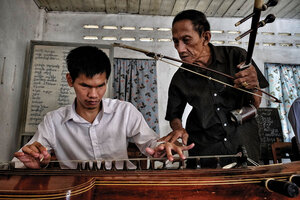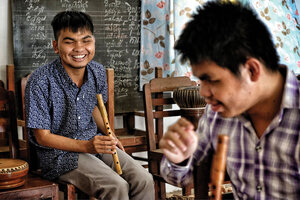In Pictures: For blind musicians, Khmer culture sings

Saron (left) plays a melody on the takhe under the watchful eye of his teacher, Ros Samoeun. Saron is one of four youths – all of whom are blind – studying music at the Khmer Cultural Development Institute in Kampot, Cambodia.
OSCAR ESPINOSA
Kampot, Cambodia
At 3:00 in the afternoon, the intense heat in the quiet city of Kampot, in southern Cambodia, makes the streets practically deserted. Along one of the avenues, music from a classroom escapes into a garden. Inside, four students – all of whom are blind – practice with deep concentration.
Chourn Reach sets the melody with his tro, a two-stringed, bowed instrument; Saron occupies a large part of the music room with a takhe, a kind of three-stringed floor zither in the shape of a crocodile; Iem Rokhthai plays a kind of flute called khloy; and Kan Prak is in charge of percussion with the skor, made up of two small drums.
“This is the time of the day I enjoy the most,” Saron says, sitting in front of his instrument. The others nod in agreement.
Why We Wrote This
Traditional arts were crushed under the Khmer Rouge. But a school for orphans helps pass musical and poetic traditions down to future generations.
The small Mohori music ensemble – Mohori is a type of traditional Khmer music – rehearses at the Khmer Cultural Development Institute (KCDI), a nongovernmental organization that emerged in 1994 to care for orphaned children and preserve the traditional arts. Many of these arts are in danger of being lost in the years since the Cambodian genocide perpetrated by Maoist Khmer Rouge. For three decades, hundreds of children have passed through the KCDI, where they have found refuge and training. Many have gone on to become professional artists. The center currently houses 10 orphaned children between the ages of 5 and 17, as well as the four musicians, who range in age from 17 to 24.
“It gives me great pleasure to transfer my knowledge to these youths and to think that they will continue to preserve the traditional Khmer arts,” says their teacher, Ros Samoeun. After surviving a Khmer Rouge prison camp, he became a professor at the Royal University of Fine Arts in Phnom Penh and in 1997 joined the KCDI project.
Two of the older youths dropped out of school to study music full time, and a third is preparing to become a lawyer. The youngest, Kan, goes to the public school every morning, where he attends sixth grade and learns to read Braille. Kan is passionate about reciting smot poems, also known as Cambodian Buddhist chanting. Smot is usually performed at funerals by a solo singer. Its poetic texts often refer to the life and teachings of the Buddha, traditional Khmer stories, and religious and moral principles such as gratitude to parents and elders.
“It is very important to perpetuate smot and [ensure] that this centuries-old genre that the Khmer Rouge wanted to destroy ... does not disappear,” says Mr. Samoeun. “Although [the youths] still have a lot to learn, they will be in charge of transmitting this traditional musical, social, and liturgical expression to the next generation.”

